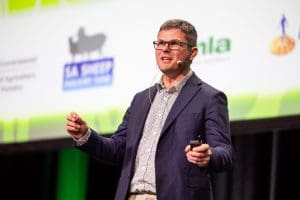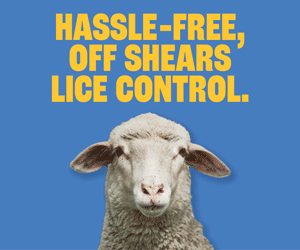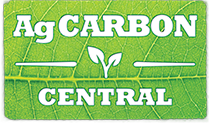
Dr Stephen Wiedemann presenting at this year’s LambEx conference. Photo: Supplied LambEx
A LEADING agricultural researcher says the sheep industry can stabilise its contribution to global warming with a steady and small reduction in methane emissions.
Integrity Ag was commissioned by Australian Wool Innovation and Meat & Livestock Australia to look at emissions reduction pathways for the industry as part of the Sheep Sustainability Framework. The organisation contracts to Australia’s major supply chain companies and producers, in sheep and beef, to measure carbon footprints.
Principal and Managing Director Dr Stephen Wiedemann said, over the past three years, the organisation has been working to introduce technologies to reduce methane and putting it into a plan that can be delivered for the sheep industry over the next 5-10 years.
He said without a “silver bullet”, methane reduction opportunities were modest.
“Based on current technologies and what we know about emissions reduction, adoption rates and costs, we think a 34pc reduction would be a pretty good effort by 2050,” he said.
Bringing fossil fuel-related CO2 emissions to zero is known as the only way to stop the gas having any further impact on global warming.
Methane emissions from livestock are different, with the gas known to break down over 10-12 years – meaning that if methane emissions are stable then they will be breaking down as quickly as they are going up.
Dr Wiedemann said the short-lived nature of methane emissions needed to be considered in setting industry targets.
 “The fact is that we can achieve the same warming outcomes with a 20-50pc reduction in methane as we can by bringing CO2 emissions to net zero.”
“The fact is that we can achieve the same warming outcomes with a 20-50pc reduction in methane as we can by bringing CO2 emissions to net zero.”
The Australian Government has set a target to make a 43pc reduction in emissions between 2005 and 2030 and bring the economy to “net zero” emissions by 2050.
“Net zero” has become a target used by hundreds of countries across the world who have signed up to the Paris Agreement, a global agreement recognising the threat of human caused climate change and a commitment to reduce the impact of it.
Dr Wiedemann said the “net zero” targets under the Paris Agreement were directed at CO2 emissions and the agreement only recommended a “strong reduction” in other gases such as methane.
However, the Australian Government’s targets do not make the distinction between the two gases and implied that the industry needs to bring methane to zero. Dr Wiedemann said bringing methane to zero would overshoot the industry’s responsibilities.
“A steady and small decline in methane will stabilise temperature,” he said.
“This is the outcome goal that society needs to get to and it won’t be achieved until 2050 with CO2, but it may can be achieved faster with a small reduction pathway for methane.”
Four levers the industry could pull
Dr Wiedemann said there were four main levers the sheep industry could pull to reach targets.
- Improving or optimising productivity
- Directly reducing methane emissions through technologies like feed addivities
- Growing more trees to sequester carbon
- Build carbon in soils
“The more ambitious your goal, the more you will have to pull all the levers. There does not appear to be a ‘silver bullet’ you can throw everything at,” he said.
Dr Wiedemann said one of the big breakthroughs in decades of research into methane reduction has been the development of feed additives that directly address methane – being seaweed asparagopsis and 3 NOP Bovaer10.
“There has been a lot more work done with this in cattle than sheep. In the cattle world we are confident of 50-85pc reduction in methane in a feedlot,” he said.
He said while the research in using the product in grazing systems is in its early stages and has only used limited number – the realistic reduction in methane is between 20-50pc.
Dr Wiedemann said there were a lot of other products that had demonstrated methane emissions reduction that could be used in grazing systems – like nitrate supplements, oils and fats, chicory, brassicas and a small range of other pastures.
“Some of these are kind of exciting. If they fit in your system and they are profitable already than they are a low-cost form of abatement,” he said.
Jury still out on soil carbon
With soil carbon, Dr Wiedemann said a limited amount of modelling made it hard to understand how much carbon soil can draw down. He said the company saw some opportunities.
“We see some paddocks on some farms offering an opportunity, where there is rundown country and high rainfall,” he said.
“The thing about soil carbon is that you will get a once-off shift that impacts the carbon account over about 20 or 30 years.
“We are in guessing territory and it is unknown how much it will offset emissions over that time – the jury is still out.”
Walking the tightrope of data
Dr Wiedemann said the industry and producers needed to work out how much money they wanted to spend on emissions reduction.
He said it was a tight rope between the consumer demand for data and what was realistic.
“Data is what is going to drive this story, it is a crucial part of the integrity message,” he said.
“We can go out and spend $20,000, $30,000 or $100,000 trying to quantify the carbon baseline, if we plan to include direct soil carbon measurement, of just one farm – and it gets to a point where it is not economically sustainable.
“Nine times out of 10, customers don’t even know the implications of what they want. They want a number, they want that number to reduce over time and it is only just dawning on them that if affects the way business operate across the other side of the planet at a seismic level.
“What we need is for all parts of the supply chain, government, customers, farmers and processors to pull together in the same direction, making realistic change to deliver low emissions into the future.”

The expert scientists cannot even measure the time it takes for methane to degrade in the atmosphere or on ground. The real science will show us that cow or sheep burping methane is broken down by hydroxyl ions and ozone immediately at ground level in actively growing pastures during daylight hours.